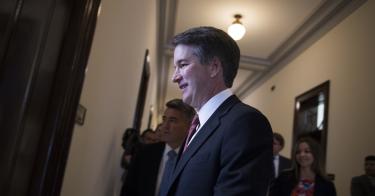Supreme Court nominee Brett Kavanaugh has been a judge on the U.S. Court of Appeals for more than a dozen years. In that time, he has authored 307 majority and separate opinions and joined 391 others. Those opinions span 8,500 pages and are publicly available.
According to Minority Leader Chuck Schumer (D., N.Y.) examining a nominee’s judicial record is the best way to evaluate the kind of justice he will be. What should the Senate look for?
Schumer suggested one standard in 2009 as the Senate considered the nomination of Justice Sonia Sotomayor. He said that if a judge follows the law rather than his personal views or empathy, he or she will not always side with a predictable party.
Let’s apply Schumer’s standard to Kavanaugh’s judicial record.
Critics claim that Kavanaugh’s personal views and biases will, for example, result in a steady stream of decisions against government efforts to protect the environment and in favor of corporate interests. The New York Times editorial board, for example, said on July 22 that Kavanaugh would “fit right in at the pro-corporate Roberts court.” Thankfully, the facts don’t support these contentions.
In American Trucking Associations v. EPA (2010), for example, Kavanaugh upheld the EPA’s emissions limits for non-road engines. In National Association of Manufacturers v. EPA (2014), he upheld the EPA’s decision to impose stricter air-quality standards for particulate matter. In Utility Air Regulatory Group v. EPA (2014), he joined Chief Judge Merrick Garland in rejecting an industry challenge to EPA rules regarding particulate matter for fossil-fuel-fired steam-generating units. In Center for Biological Diversity v. EPA (2013), he joined a ruling for environmentalists who challenged regulation of biogenic emissions. In Natural Resources Defense Council v. EPA (2014), he ruled for environmental groups challenging the EPA’s decision to create an affirmative defense in private civil suits over violation of emission standards.
Labor unions have launched a massive campaign against Kavanaugh, but they too paint a false picture. In United Food & Commercial Workers v. National Labor Relations Board (2008), Kavanaugh upheld an NLRB decision finding that Walmart had engaged in unfair labor practices by refusing to negotiate with a union. In Raymond F. Kravis Center for the Performing Arts v. NLRB(2008), he granted enforcement of an NLRB order against an employer that had withdrawn recognition of a union following a merger. In E.I. du Pont de Nemours v. NLRB (2007), he granted enforcement of an NLRB order against a company for wrongfully declaring an impasse in negotiations.
Opposition by some liberal civil-rights groups similarly ignores Kavanaugh’s record. A letter led by the Leadership Conference on Civil and Human Rights, for example, says that he would “undermine many of our core rights and legal protections.” But in Ayissi-Etoh v. Fannie Mae (2013), Kavanaugh not only joined in allowing a discrimination claim by a black employee to proceed, but wrote separately that even a single use of a certain epithet by a supervisor is enough to create a racially hostile work environment. In United States v. Nwoye (2016), he held that a woman had received ineffective assistance of counsel when her lawyer failed to introduce evidence that she suffered from battered-woman syndrome. In Essex Insurance Company v. Doe (2008), he ruled against an insurance company that was trying to limit payments to a child sexual-abuse victim.
These are just the tip of Kavanaugh’s judicial iceberg. The list is long of cases in which Kavanaugh’s rulings contradict the caricature that his critics have painted. Instead, his record meets the Schumer standard of a judge who does not predictably rule for a particular side. That is because Kavanaugh is the kind of judge who follows the law rather than his personal views.
This piece originally appeared in National Review




